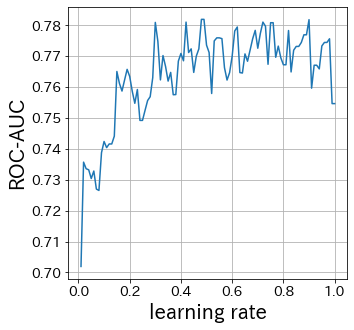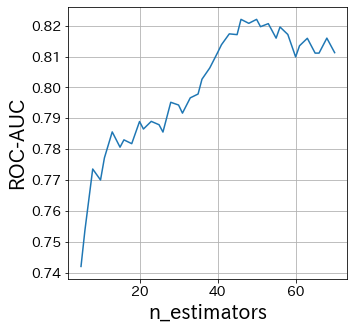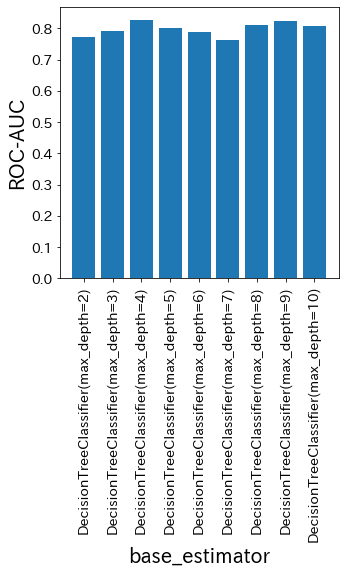AdaBoost is a boosting method that focuses more on hard samples by reweighting misclassified points and fitting the next weak learner accordingly.
Algorithm (with formulas) #
For rounds \(t=1,\dots,T\), fit a weak learner \(h_t(x)\) with weights \(w_i^{(t)}\). Weighted error:
\(\displaystyle \varepsilon_t = \frac{\sum_i w_i^{(t)} , \mathbf{1}[y_i \ne h_t(x_i)]}{\sum_i w_i^{(t)}}\), coefficient \(\displaystyle \alpha_t = \tfrac{1}{2}\ln \frac{1-\varepsilon_t}{\varepsilon_t}\).
Update sample weights: \(\displaystyle w_i^{(t+1)} = w_i^{(t)} \exp( \alpha_t, \mathbf{1}[y_i \ne h_t(x_i)] )\) (then normalize).
Final classifier: \(\displaystyle H(x) = \operatorname{sign}\big( \sum_{t=1}^T \alpha_t h_t(x) \big)\)
Training on synthetic data #
import numpy as np
import matplotlib.pyplot as plt
import japanize_matplotlib
from sklearn.datasets import make_classification
from sklearn.model_selection import train_test_split
from sklearn.metrics import roc_auc_score
from sklearn.tree import DecisionTreeClassifier
from sklearn.ensemble import AdaBoostClassifier
n_features = 20
X, y = make_classification(
n_samples=2500,
n_features=n_features,
n_informative=10,
n_classes=2,
n_redundant=4,
n_clusters_per_class=5,
random_state=42,
)
X_train, X_test, y_train, y_test = train_test_split(
X, y, test_size=0.33, random_state=42
)
ab = AdaBoostClassifier(
base_estimator=DecisionTreeClassifier(max_depth=2),
n_estimators=10,
learning_rate=1.0,
random_state=117117,
)
ab.fit(X_train, y_train)
y_pred = ab.predict(X_test)
print("ROC-AUC:", roc_auc_score(y_test, y_pred))

Hyperparameters #
learning_rate #
Smaller → slower but steadier; larger → may hinder convergence. Trade-off with n_estimators.
scores = []
learning_rate_list = np.linspace(0.01, 1, 50)
for lr in learning_rate_list:
clf = AdaBoostClassifier(
base_estimator=DecisionTreeClassifier(max_depth=2),
n_estimators=10,
learning_rate=lr,
random_state=117117,
).fit(X_train, y_train)
scores.append(roc_auc_score(y_test, clf.predict(X_test)))
plt.figure(figsize=(5, 5))
plt.plot(learning_rate_list, scores)
plt.xlabel("learning rate")
plt.ylabel("ROC-AUC")
plt.grid()
plt.show()

n_estimators #
More rounds increase capacity but risk overfitting and cost.
scores = []
n_estimators_list = [int(ne) for ne in np.linspace(5, 70, 20)]
for ne in n_estimators_list:
clf = AdaBoostClassifier(
base_estimator=DecisionTreeClassifier(max_depth=2),
n_estimators=ne,
learning_rate=0.6,
random_state=117117,
).fit(X_train, y_train)
scores.append(roc_auc_score(y_test, clf.predict(X_test)))
plt.figure(figsize=(5, 5))
plt.plot(n_estimators_list, scores)
plt.xlabel("n_estimators")
plt.ylabel("ROC-AUC")
plt.grid()
plt.show()

base_estimator #
Compare decision trees with different depths.
scores = []
bases = [DecisionTreeClassifier(max_depth=md) for md in [2,3,4,5,6]]
for base in bases:
clf = AdaBoostClassifier(
base_estimator=base, n_estimators=10, learning_rate=0.5, random_state=117117
).fit(X_train, y_train)
scores.append(roc_auc_score(y_test, clf.predict(X_test)))
plt.figure(figsize=(6, 5))
idx = range(len(bases))
plt.bar(list(idx), scores)
plt.xticks(list(idx), [str(b) for b in bases], rotation=90)
plt.xlabel("base_estimator")
plt.ylabel("ROC-AUC")
plt.tight_layout()
plt.show()
Takeaways #
- Reweights hard samples to improve them in later rounds.
- Balance learning_rate × n_estimators.
- Weak learners are typically shallow trees; overly strong bases weaken boosting effects.